Jewelry from ancient Egypt
Whoever thinks of the treasure of Tutankhamun, immediately thinks of gold and jewelry. Nowhere else has so much ancient Egyptian jewelry been found together as in the famous tomb of this Pharaoh. But the jewels of Tutankhamun form only part of the body of jewelry ever found in ancient Egypt. Although much got lost because of grave robbery and remelting, museum collections around the world still give a sublime picture of the variety of materials, techniques and forms used for manufacturing these valuables.
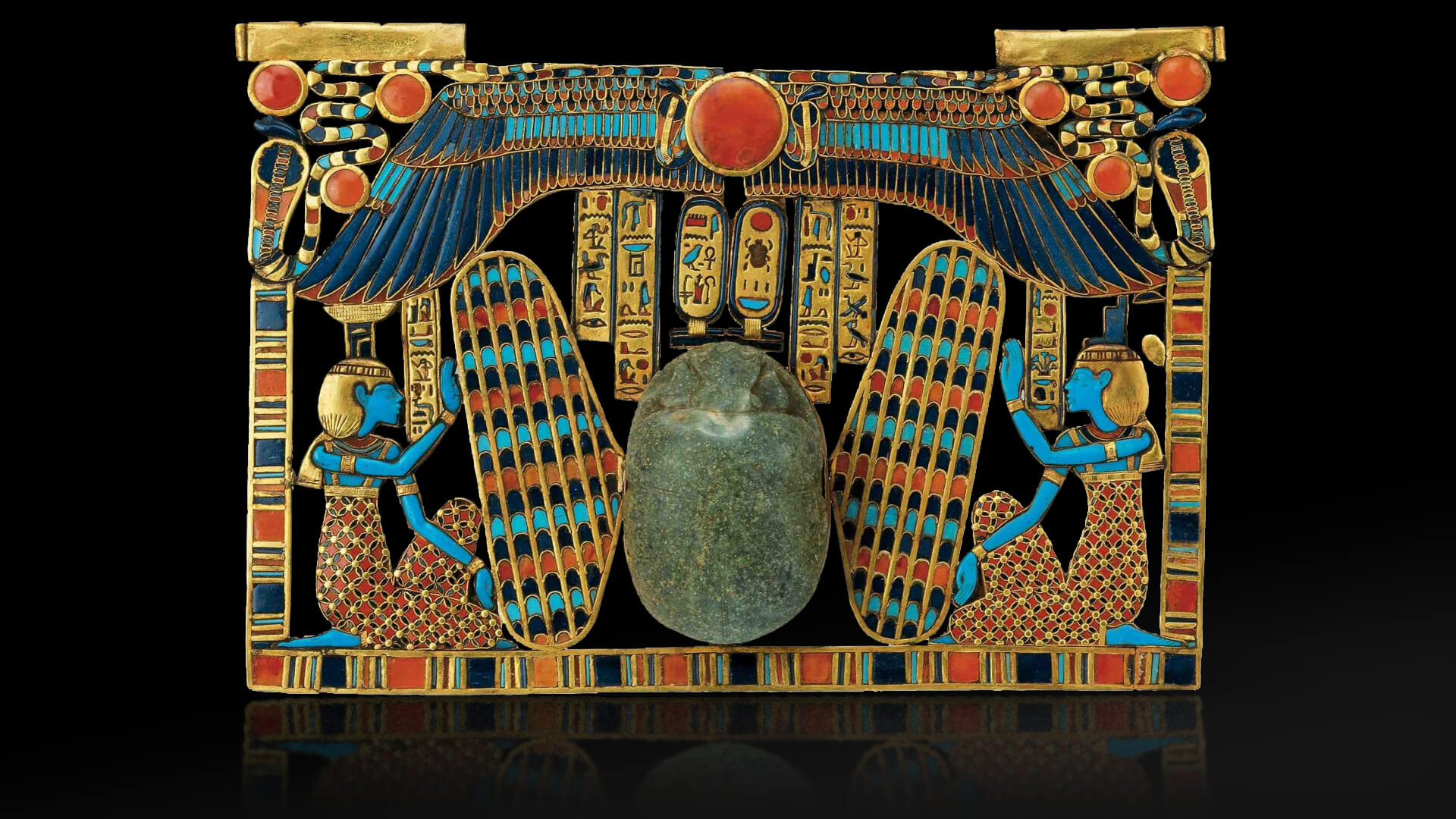
Tutankhamun. Inlaid pectoral, scarab beetle with Isis and Nephthys
Winged, large scarab beetle riding on a sacred barque and flanked by the goddesses Isis and Nephthys. The scarab serves a double function: as a heart scarab and as the ba of the sun god lighting the way to the underworld.
Egyptian Jewelry Aesthetics
The main reason for wearing jewelry is because of its aesthetic function. The Egyptians were quite soberly dressed in white linen fabrics, and jewelry offered a possibility for contrast. The Egyptian preference was towards the use of bright colors, lustrous stones and precious metals. Gold was won in large quantities in the eastern desert of Egypt, but also came from Nubia, that was an Egyptian colony for centuries.
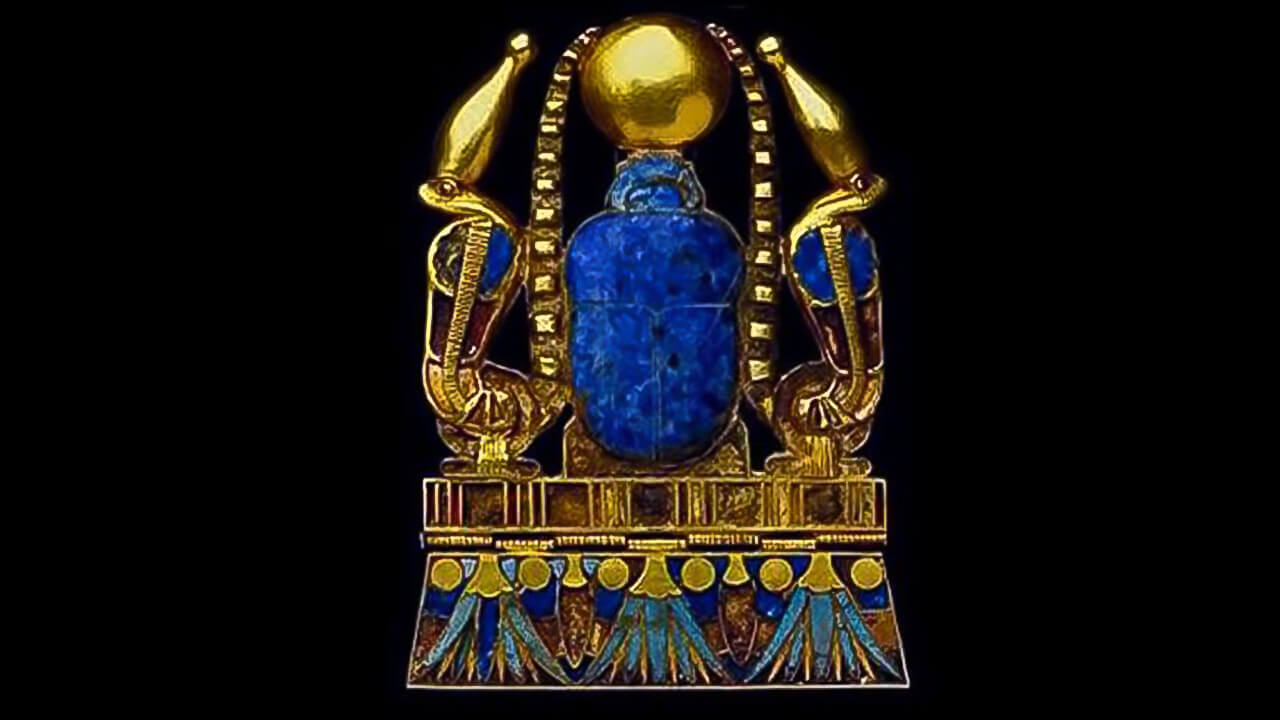
Ancient Egyptian Jewel: the cobras of protection
Ancient Egyptian jewel The cobras of protection on each side wearing the crown of Upper Egypt; the lotus & suns on bottom edge represent immortality; the lapis lazuli representative of the sky & stars; the turquoise is for long life; the carnelian for protection. The shen is for immortality & protection; the crook represents power. The square is the earth & the 3 bars are for the cycle of birth, death & rebirth.The scarab sits atop the mountain or afterlife. Egyptian Museum, Cairo.
On the other hand, silver was rare and was imported from Asia. Therefore it was silver that was often considered more precious than gold. The eastern desert was also an important source for colorful semi-precious stones such as carnelian, amethyst and jasper. In the Sinai were turquoise mines, the deep blue lapis lazuli had to come from far away Afghanistan. Glass and faience (glaze over a core of stone or sand) were favorites to replace rocks because they could be produced in many colors.
Amulets
Adornment was not the only role of jewelry use. They played a protective role as amulets as well. Already in prehistoric times did the Egyptians wear beaded necklaces and bone jewelry on the most vulnerable areas of their bodies: neck, wrists and ankles. Amulets protected the wearer from evil influences, diseases and other accidents. The carrier of a god-figurine was under the protection of this particular deity; the dwarf-god Bes was the protector of pregnant women and children for example. Also the well-known Eye of Horus repelled evil. Other symbols emphasized positive traits such as fertility and prosperity. The scarab was a symbol of new life after death.
A magical role was also attributed to color and material of the amulets.
Wealth and status in ancient Egypt
A third function of jewelry was the show of wealth and status. The King himself distinguished himself from his people by wearing special crowns and diadems, all with the Royal cobra (uraeus).
The Pharaoh rewarded his most successful officers with jewelry and so-called “honorary gold” attributes. In the Middle Kingdom (2040-1640 BC), this was in the form of oyster shells on which was engraved the name of the Pharaoh. During the new Kingdom (1550-1070 BC), the honorary gold were wide collars and various types of bracelets.
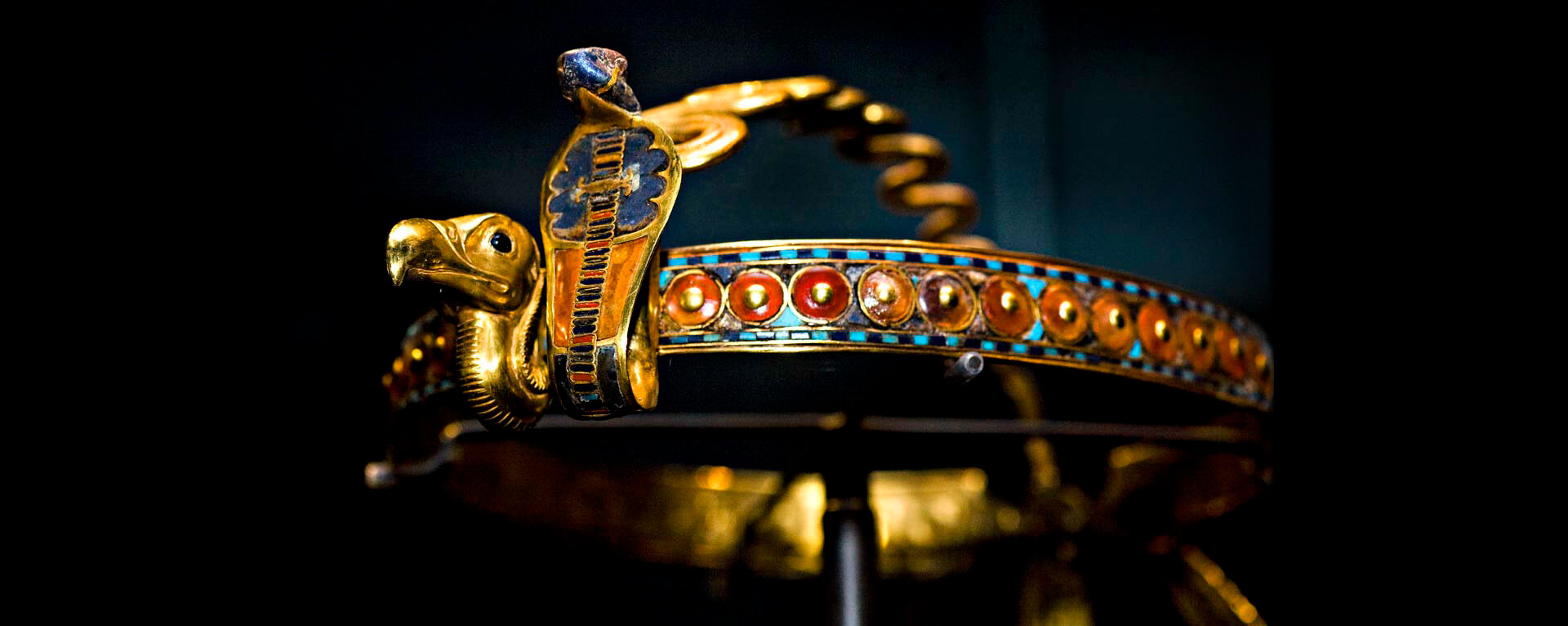
Diadem King Tutankhamun, The Egyptian Museum, Cairo
Special Section about: Tutankhamun’s scarab bracelet
The small circumference of this bracelet suggests that it was made for Tutankhamun when he was a child. Nevertheless, it agrees very closely in size with the bracelets that were placed on the forearms of his mummy and were thought by Carter to have been worn by the king in his lifetime. It was found in the cartouche-shaped box that contained several other objects, including the fine pair of earrings which also seem to have been personal possessions.
The bracelet’s central feature is a gold openwork scarab encrusted with lapis lazuli. On each side is a narrow raised band composed of gold, lapis lazuli, turquoise, quartz, and carnelian inlay, bordered on the inner edge with gold granules. The bands are continued on the back of the hoop. Two identical botanical ornaments flank the scarab, each consisting of a mandrake fruit supported by two poppy buds, with gold marguerites filling the interstices between the stems of the mandrake and the buds. The yellow and green colors of the mandrakes are painted at the back of the translucent quartz inlay. Both the hinge and the fastening are made of interlocking cylindrical teeth held together by long gold pins, the hinge pin being fixed and the other movable.
The ancient Egyptians adopted the scarab (Ateuchus sacer) as a symbol of the sun-god because they were familiar with the sight of the beetle rolling a ball of dung on the ground and this action suggested to them that the invisible power that rolled the sun daily across the sky could be represented pictorially as a scarab. Moreover, they had noticed that the young beetle emerged from a ball of dung by what they imagined to be an autogenic process, so that a further parallel was seen between this creature and the sun-god, who was also credited with having created himself. In reality the ball of dung rolled by the scarab is only a reserve supply of food that it hides in a convenient crevice, whereas the ball containing the egg is pear-shaped and is never moved from the burrow in which it is placed by the female. In the Egyptian language the words for the scarab and for existence

Gold Bangle with Openwork Scarab Encrusted with Lapis Lazuli, Tutankhamun, The Egyptian Museum, Cairo
were identical (kheper), and the name of the sun-god, on his first appearance every morning, was Khopri. In hieroglyphic writing the scarab sign was used for all three words.
In spite of black being the color of the scarab in nature, the Egyptians seldom copied it in their reproductions, perhaps because there was no native semi-precious stone of that color, and obsidian was not easily obtainable. Quite exceptionally, however, two scarabs placed on Tutankhamun’s mummy were made of black resin. Glazed specimens were usually green or light blue, and it is clear that no importance was attached to reproducing an exact likeness of the living beetle. Lapis lazuli, the material used for most of the scarabs in Tutankhamun’s collection of jewelry, has not been found in Egypt, the nearest source know at present being Badakhshan in the northeast of Afghanistan.
Jewelry is not just for women
Jewelry was worn by everyone: men, women and children. Certain jewelry is more associated with one than with the other sex, such as earrings which were mainly worn by women during the new Kingdom. Also the gods were adorned with jewelry. For example, in the temple worship of the goddess Hathor heavy necklaces were worn which were balanced by a counterweight (menat) hung from their backs. And in other temple dances a collar-shaped attribute (aegis) was heavily swung around. The dead received their belongings in their graves as the mummy was often adorned with jewelry and amulets. These attributes had to ensure the dead made a safe transition to the underworld. Jewelry for mummies was often made of thin sheet gold because they did not need to be worn (by the living) and could thus be more fragile. It is predominantly the jewelry from graves and from hidden temple treasures which have been preserved.

A collection of different amulets
Including fourteen scarabs of steatite, faience, amethyst, rock crystal, lapis lazuli and carnelian, some with motifs on the undersides; together with a red steatite, black steatite and a glass heart amulet; one lapis lazuli and two carnelian djed-pillars; a lapis lazuli four-headed ram; a lapis lazuli lotus-seed pendant; and a lapis lazuli ibis-headed Thoth; all mounted together as a necklace in a modern Egyptian revival gold, enamel and gem stone setting 21½ in. (54.6 cm.) long. Middle Kingdom to Ptolemaic period 2040-30 B.C. Photo courtesy of Christie’s
What are Egyptian amulets
Amulets are small objects or ornaments that are supposed to protect both the living and the dead against dangers or provide them with a special power. The faith in such objects is still widespread in many cultures today. The Egyptians too attached great importance to the power of amulets. In prehistoric burial fields we find the dead adorned with bead necklaces of special materials or provided with special pendants and other figures.
The magical effect of amulets is quite diverse. The shape of the amulet can be sufficient to transfer the power of that which is impersonated by the amulet on the carrier. But some materials also have magical powers of their own. In addition color can have a special effect. Finally, the amulet’s magic can vary per individual, at different times and in different places. There are over three hundred types of amulets known, divided into god figures, animal figures, body parts, utensils and hieroglyphics. Very popular were amulets in the form of a Horus-eye or of a heart vase. Amulets were usually made in series and were especially common during the ending days of the Egyptian civilization.
The magical effect of an amulet
can be based on different aspects. First of all, the magic of an amulet is based on its form. An amulet represents a certain deity, an animal, a body part, a letter or other abstract symbol, and because of that visual similarity also carries the magical power of that which it impersonates. Secondly, amulets can involve material magic: certain materials found in nature or created by humans, were considered to possess supernatural powers.
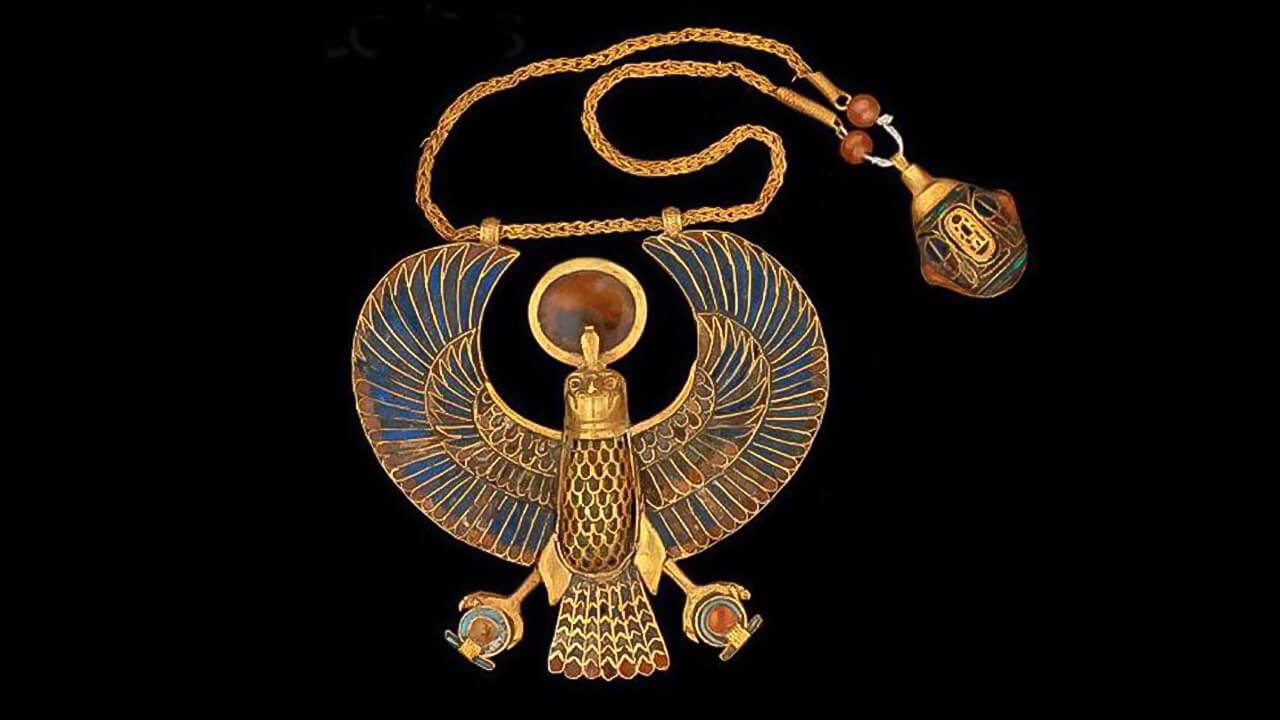
Necklace with falcon pendant, Tutankhamun, The Egyptian Museum, Cairo
Thirdly, color symbolism plays a role in amulets: in every culture certain colors have a special meaning, which in part is derived from natural conditions of their environment but also partly can only be understood through culture specific connotations. Fourthly, an amulet worn at a certain place on the body, at a specific time or could only be worn by a particular person to be really effective. All in all it teaches us a lot about how the study of amulets the Egyptians thought about the functioning of nature and of the human body.
The use of amulets always played a large role in Egypt
The difference between jewelry and amulets is often hardly noticeable. In total, there are over three hundred different types of Egyptian amulets known. They date from all periods of history and some forms remained popular for thousands of years. In the last millennium BC the use of amulets (at least in the graves) exploded. Often dozens of copies of an amulet were found between the drapings of a single Mummy.
It seemed as if the Egyptians — with the increasing political difficulties of that period, and with the continuing impoverishment of large parts of the population — used these small and inexpensive figurines as their last resort. In this time amulets were massively made of faience, a glazed ceramic material that could be printed and baked as paste in molds. However, the higher quality copies were still still carved in stone.
Different god figurines
Very popular were small god figurines of protective powers. These include Bes, the dwarf-god who — with his fearsome lion mask — can drive out any evil. The so-called pataeke was a dwarf figure that was connected with the resurrection-god Ptah-Sokaris-Osiris. On his head he wears a scarab, also often a sign of resurrection.

Goddess Isis Pendant
This pendant belonged to General Undjebauendjed and represents the Goddess Isis. The Egypt Museum, Cairo. JE 87716-CEM-31 08 09 001; gold; H. 11cm; 21st Dynasty, Third Intermediate Period
The god with the head of the jackal is Anubis, the guardian of the cemetery and of the Mummy. The pregnant hippopotamus is an image of Taweret, the special protector of women and children. Figurines of Nephthys and Isis with her child Horus refer to the Osiris-Osiris myth and offer the deceased as new divine help to overcome death. All these figurines are made of faience and have a green blue glaze. This color should be seen as a symbol of life.
Animal figurines
Of the animal figures used in amulets the Apis-bull was the most important, and which was connected with Osiris and Ptah. Another one was the buck of the god Amon. The scarab or dung beetle — representing resurrection — was probably the most common animal amulet and did also serve as a seal stone in rings.
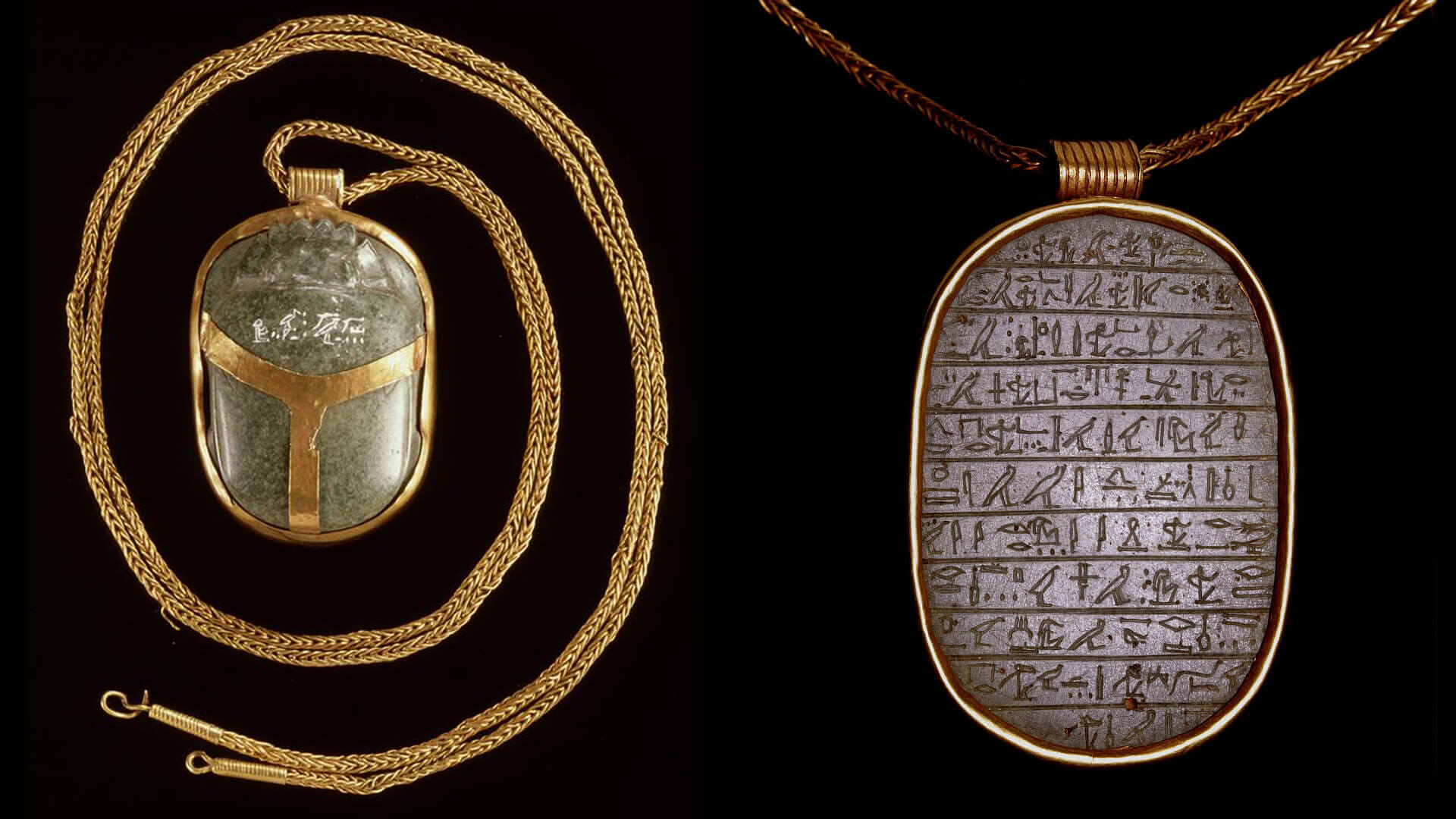
Heart scarab of Djehoety
This ornament was designed for a deceased. On the belly of the scarab is a spell from the book of the dead. Describes the heart asked not to testify against his owner during the so-called targeted killing. The scarab is enclosed in a gold frame and is attached to a chain of crochet gold rings. On the back of the jewel is read that it belonged to Djehoety, a General under King Thutmose III. With other precious jewels, the scarab on Djehoety’s Mummy. After the discovery of his tomb in Saqqara in 1824 were these objects spread over several museums. Saqqara; CA. 1450 BC.
This object originates from the collection of the Greek diplomat Giovanni d’Anastasi. Leiden, National Archaeological Museum. 1490 – 1436 BC. 8.3 x 5.4 x 133 cm
A very general amulet was also the eye of Horus or wedjat-eye (the affluent) to protect oneself from evil. This is in fact the image of one of the eyes of the Sky God and falcon-shaped Horus (hence the curious curls underneath the eye representing the typical patterns head of a falcon).

Collar of Neferuptah
This necklace is one of the treasures discovered in the tomb of Princess Neferuptah , daughter of Amenemhat III , at Hawara . This attractive collar is made of six strings of carnelian and feldspar beads and a row of drop-shaped motifs in the lower edge . The clasp of the collar is also shaped as a falcon head with some rows of brightly colored cylindrical beads. The falcon head in this necklace is used to show that the deceased would be protected by the god-falcon Horus in the hereafter .
Material: Gold , Carnelian , Feldspar , and Glass Paste
Found in: Hawara , Pyramid of Princess Neferuptah (1894)
Period: MIDDLE KINGDOM
Reign of: Amenemhet III
Dynasty: XII
Belonged to: Princess Neferuptah
Museum: The Egyptian Museum, Cairo, Egypt
Also the heart, in the shape of a vase-shaped object, belongs to the most common amulets. The explanation for this lies in the court of the death where the heart was weighed by the gods.
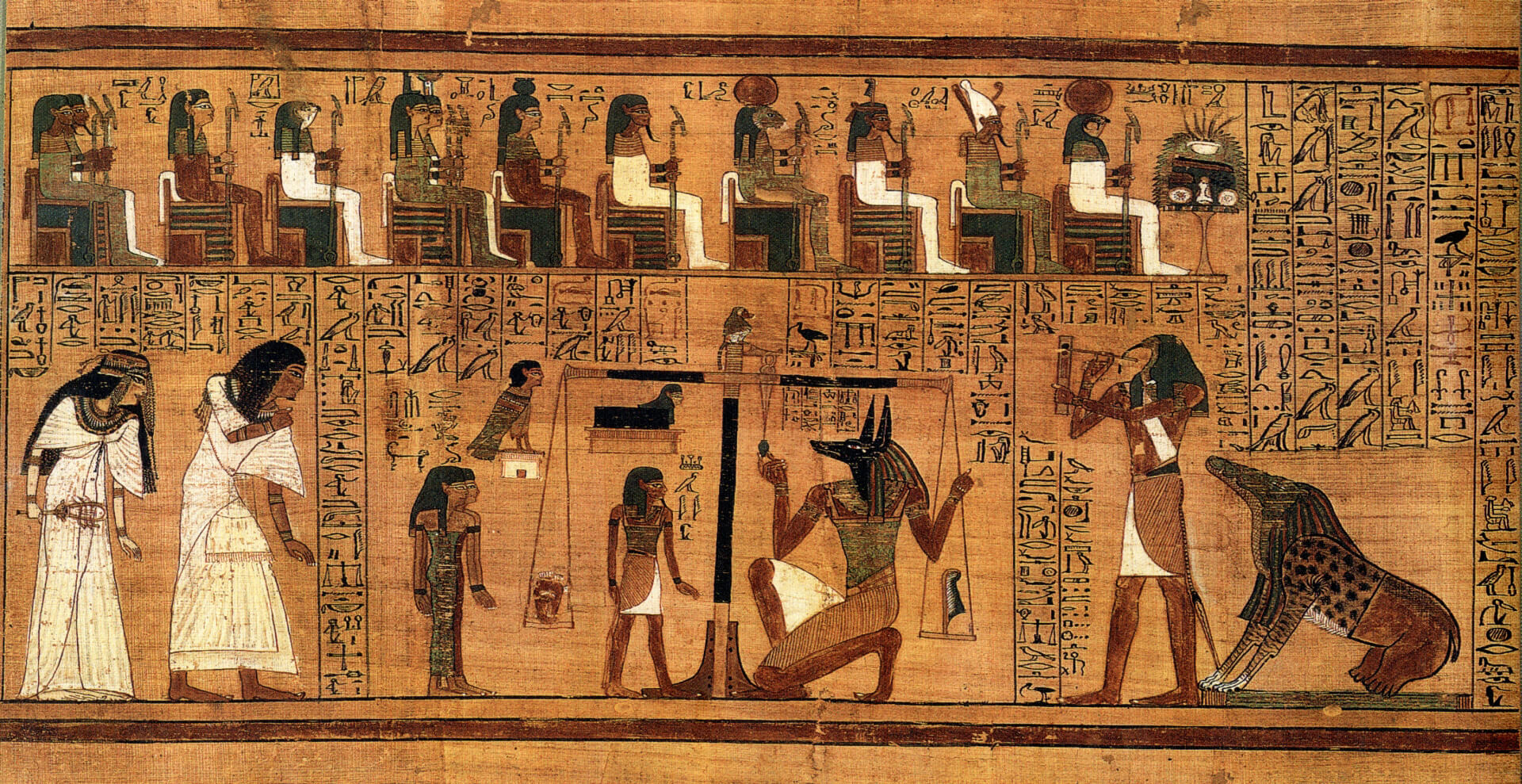
Weighing of the Heart Book of the Dead written on papyrus showing the “Weighing of the Heart” in the Duat using the feather of Maat as the measure in balance
All this takes place after the mummification and burial of the deceased.
- Anubis who is the protector of the dead is a deceased go get and brings him now in
- Anubis which is the heart of the dead weights while Ma-ät supports the scales. It is suggested the dead a number of questions. He has hungry food given, he has done well for the sick, ….
- The seated figures at the top of his assistant judges that Osiris right judgement. They all should be one of the questions at the roads.
- Amemet is ready to devour the heart had to weigh heavy.
- Toth who writes down everything as god of the writers.
- After the Court (and the dead lived well) brings him to Osiris Horus.
- On the lotus flower are 4 statuettes. These refer to the 4 sons of Horus.
- Osiris is waiting until Horus the dead brings with him. Behind Osiris are two goddesses. (Isis and Nephtys). Only after their encounter, the dead enter the realm of the dead.
Special symbols as amulets
Certain attributes, such as miniature crowns, had to increase the status of the dead in the afterlife, a thought that was already expressed by the freeze figures on the coffins in the Middle Kingdom. Finally, there are a number of amulets which by means of the characters in the hieroglyphics represent certain abstract concepts. The most well-known of these is the “life sign” or handle cross: a sign that in the Egyptian writing sounds like “Ankh”. Very generally used were also “djed-pillar of Osiris”, also known as a sign of durability, and the protective Tyet or Isis-knot. That knot is also called Isis blood and usually has a red color. The papyrus column also belongs to this group. This representation of a papyrus stem is a representation of the hieroglyph wadj (green, prosperous, healthy) and is thus always in the color green.
